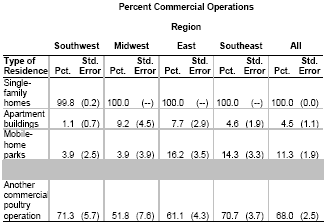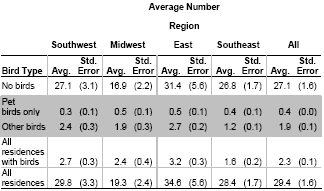



Poultry ‘04: Reference of Health and Management of Backyard/Small Production Flocks in the United
By The National Animal Health Monitoring System - This article is Part I of NAHMS's most recent study of the U.S. poultry industry.Contents
- Introduction
- Terms Used In This Report
- Section I: Population Estimates
- Circle-Level Tables
- Residence density within sampling circle
- General Management for Backyard Flocks (Residences with Birds Other Than Pet Birds or in Addition to Pet Birds)
- Bird types
- Distances
- Housing
- Animal contact
- Health and Health Care
- Veterinary services
- Medication
- Vaccinations
- Bird health
- Health resources
- Biosecurity
- Dedicated footwear and clothing
- Hand washing
- Visitors
- Ponds and bird feeders
- Bird Movement
- Introduction of birds
- Sales
- Other locations with birds
- Carcass and Litter Disposal
- Dead birds
- Litter
- Producer Characteristics
- Reason for having birds
- Years of bird ownership
- Employment in commercial poultry industry
- Membership in avian associations
- “Biosecurity for the Birds” awareness
- Circle-Level Tables
- Section II: Methodology
- Needs Assessment
- Sampling and Estimation
- State selection
- Commercial poultry operation selection
- Residence identification and sampling
- Population inferences
- Data Collection
- Data analysis
- Validation and estimation
- Response rate
- Appendix I: Sample Profile
- Appendix II: U.S. Poultry Statistics—2004
- Appendix III: Poultry ‘04 Study Objectives and Related Outputs
Introduction
The National Animal Health Monitoring System (NAHMS) is a nonregulatory
division of the United States Department of Agriculture (USDA) designed to
help meet the Nation’s animal-health information needs.
Layers ’99 was NAHMS’ first national study on poultry baseline health and
management. Layers ’99 estimated the prevalence and associated risk factors
of Salmonella enterica enteritidis in U.S. layer flocks.
Poultry ’04 is NAHMS’ second study of the U.S. poultry industry. For Poultry ’04,
NAHMS conducted a thorough assessment to determine the information needs
of the poultry industry, researchers, and Federal and State governments. This
needs assessment indicated a need for information regarding bird health, bird
movement, and biosecurity practices of nontraditional poultry industries, such
as backyard flocks, gamefowl, and live poultry markets.
Part I: Reference of Health and Management of Backyard/Small Production
Flocks in the United States, 2004 is the first in a series of reports containing
national information from the Poultry ’04 study. Data for Part I were collected
via a questionnaire administered to owners of backyard flocks in 18 major
poultry producing States (see map next page). A sample of large commercial
poultry operations (n = 350) with at least 10,000 chickens or 5,000 turkeys was
selected, and then a circle with a 1-mile radius was “drawn” around each of
these selected operations. VMOs, many of whom had gained previous areascreening
experience during the exotic Newcastle disease outbreaks in
California, canvassed the circles for residences with birds. Residences with
birds other than pet birds (backyard flocks) were asked to complete a
questionnaire describing their management and biosecurity practices.
A total of
349 of the 350 circles were canvassed. Over the 349 circles screened, there
were 10,579 residences contacted, of which 156 had pet birds only and 763
had birds other than pet birds (backyard flocks). In addition, there were 668
commercial poultry operations (other than the ones selected to serve as the
centers of the circles) within the 349 circles. Since the design and analysis of
this study are probability based, estimates presented describe backyard flock
attributes “near” the population of commercial operations within the 18 States.
Terms used in this report
Backyard flocks: Residences with birds (other than pet birds or in addition to
pet birds). Backyard flocks have fewer than 1,000 birds.
Commercial poultry operations: Operations with 1,000 or more birds
(domestic poultry).
Flock size: Total number of birds present (including pet birds) on the day of the
interview. Small flocks are those with fewer than 20 birds; medium flocks are
those with 20 to 99 birds; and large flocks are those with 100 to 999 birds.
Pet birds: Birds not normally used for food and usually housed in cages in the
home, such as parrots, cockatiels, parakeets, finches, and canaries.
Population estimates: Estimates in this report are provided with a measure of
precision called the standard error. A 95-percent confidence interval can be
created with bounds equal to the estimate, plus or minus two standard errors. If
the only error is sampling error, the confidence intervals created in this manner
will contain the true population mean 95 out of 100 times. In the example to the
left, an estimate of 7.5 with a standard error of 1.0 results in limits of 5.5 to 9.5
(two times the standard error above and below the estimate). The second
estimate of 3.4 shows a standard error of 0.3 and results in limits of 2.8 and
4.0. Alternatively, the 90-percent confidence interval would be created by
multiplying the standard error by 1.65 instead of 2.0. In general, when
comparing point estimates between categories, estimates with confidence
levels that overlap are not considered different. Most estimates in this report
are rounded to the nearest tenth. If rounded to 0, the standard error was
reported. If there were no reports of the event, no standard error was reported.
Differences identified in this report are at the 95-percent confidence level.
Residences: All homes—with and without birds—within a 1-mile radius of a
selected commercial poultry operation, including
- Mobile-home parks—a group of five or more trailers or mobile homes,
- Apartment buildings—any building of five or more connected units, such as apartments, condominiums, and townhome buildings, and
- Single-family homes—single, detached dwellings (including up to four mobile homes) and multiplexes (duplexes, triplexes, and fourplexes) that stand on their own. Each unit was counted separately, e.g., a fourplex was counted as four units.
Section I: Population Estimates
A. Circle-Level Tables
Note: Each selected commercial poultry (layer, broiler, or turkey)
operation served as the center point of a circle (sampling circle) with a
1-mile radius. Each sampling circle was canvassed for residences that
housed birds. Data for the study were collected from participating
residences with birds other than or in addition to pet birds within the
sampling circles.
1. Residence density within sampling circle
Almost all sampling circles contained one or more single-family homes.
Apartment buildings and mobile-home parks were found within the sampling
circles of 4.5 percent and 11.3 percent of commercial operations, respectively.
About two-thirds of selected commercial poultry operations (68.0 percent) had
another commercial poultry operation within their sampling circles.
a. Percentage of commercial poultry operations, by type of residences found
within the 1-mile-radius sampling circles surrounding those operations and by
region:

Overall, commercial poultry operations averaged 29.4 residences per sampling
circle, with a range of 19.3 residences in the Midwest region to 34.6 residences
in the East region. An average of 27.1 residences per sampling circle had no
birds; 0.4 residences had pet birds only; and 1.9 residences had birds other
than or in addition to pet birds (backyard flocks). Some residences in the “no
bird” category may have had birds in the spring and summer; however, data
were collected during the fall.
b. Average number of residences per 1-mile-radius sampling circle, by bird type
at those residences and by region:

Further Information
To read the full report, please click here (91 page PDF)
Source: Animal and Plant Health Inspection Service - June 2004








